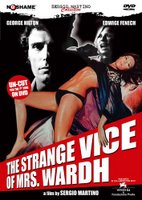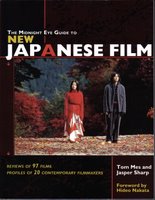This is just about the funniest damn thing I've seen in awhile, as well as the most clever. It's the winning entry in a contest open to film editors' assistants held by the New York chapter of the Association of Independent Creative Editors. The objective was to take a real film, in this case Stanley Kubrick's classic The Shining, and make a new trailer for it but in a completely different genre. The result of Mr. Ryang's endeavor is simply brilliant:
http://www.ps260.com/molly/SHINING%20FINAL.mov
You can read more about this story here and here. And yes, I realize that this story has been floating around for awhile, but then . . . so have I.
Thursday, December 15, 2005
Wednesday, December 14, 2005
Like Love, Only More So: The Strange Vice of Mrs. Wardh (1971)
 And man, what a vice. Sultry euro-starlet Edwige Fenech (All the Colors of the Dark, The Case of the Bloody Iris, Your Vice Is a Closed Room and Only I Have the Key) stars as a businessman’s wife who accompanies her boring husband to Vienna so that he can conduct his dreary financial affairs with other boring businessmen. So what’s a luscious, vivacious sexpot to do? Why, conduct an affair of her own, of course. Unfortunately, Mrs. Wardh has a suppressed hunger for violent sex—hence the title--and the volatile men who can give it to her. And one of her ex-paramours still carries a flame for her. Too bad he may also be a psychopathic killer. This stylish, ruthless, and seductively enticing psychological thriller is pure entertainment for fans of the Italian giallo genre. Director Sergio Martino (All the Colors of the Dark, Violent Professionals, Torso) keeps the pace moving, the murders plentiful, and the convoluted plot twists and red herrings overflowing in psychedelic splendor. The film also stars George Hilton (who made several films with Fenech) as a sleazy lothario bent on troubling Fenech’s waters. In other words, it’s a certified classic of the genre.
And man, what a vice. Sultry euro-starlet Edwige Fenech (All the Colors of the Dark, The Case of the Bloody Iris, Your Vice Is a Closed Room and Only I Have the Key) stars as a businessman’s wife who accompanies her boring husband to Vienna so that he can conduct his dreary financial affairs with other boring businessmen. So what’s a luscious, vivacious sexpot to do? Why, conduct an affair of her own, of course. Unfortunately, Mrs. Wardh has a suppressed hunger for violent sex—hence the title--and the volatile men who can give it to her. And one of her ex-paramours still carries a flame for her. Too bad he may also be a psychopathic killer. This stylish, ruthless, and seductively enticing psychological thriller is pure entertainment for fans of the Italian giallo genre. Director Sergio Martino (All the Colors of the Dark, Violent Professionals, Torso) keeps the pace moving, the murders plentiful, and the convoluted plot twists and red herrings overflowing in psychedelic splendor. The film also stars George Hilton (who made several films with Fenech) as a sleazy lothario bent on troubling Fenech’s waters. In other words, it’s a certified classic of the genre.More Fenech and gialli to come . . . .
The Strange Vice of Mrs. Wardh is available on DVD from NoShame Films.
Saturday, December 10, 2005
A Humble Confession
I told myself I wasn’t going to do it. I told myself I was never going to give George Lucas another damned dollar and that he had ruined the Star Wars franchise after the abysmal, craptacular entries The Phantom Menace and Attack of the Clones. Hell, I didn’t even like Return of the Jedi when it originally came out and it was only years later that I sort of came to terms with its childish entertainment value. But I have to humbly admit that I was wrong about Revenge of the Sith.
It was awesome.
A couple of nights ago I finally sat my ass down to watch it on DVD. Strangely, I was looking forward to suffering through it. Perhaps I simply wanted to get it out of the way and feel superior to it, brag to my friends that I had witnessed yet another shitty film by Lucas and that I had been right all along—he was a hack and a fraud. Well, he may not be the best director around and he’s certainly not a good writer (but we’ve all known that for decades, right?), but damn if he didn’t pull out all the stops with this presumably final and certainly important film in the series. I won’t bore you with reviewing it—most of you have already seen it and have chosen sides—but I just want to publicly confess to those friends who were urging me to see it and who insisted that it was not a waste of time. You were right. And for the first time since Return of the Jedi, Lucas actually made a Star Wars film that felt like a real goddamn Star Wars film. Who knew he still had it in him?
Then again, perhaps it was the bottle of wine that helped me through it.
It was awesome.
A couple of nights ago I finally sat my ass down to watch it on DVD. Strangely, I was looking forward to suffering through it. Perhaps I simply wanted to get it out of the way and feel superior to it, brag to my friends that I had witnessed yet another shitty film by Lucas and that I had been right all along—he was a hack and a fraud. Well, he may not be the best director around and he’s certainly not a good writer (but we’ve all known that for decades, right?), but damn if he didn’t pull out all the stops with this presumably final and certainly important film in the series. I won’t bore you with reviewing it—most of you have already seen it and have chosen sides—but I just want to publicly confess to those friends who were urging me to see it and who insisted that it was not a waste of time. You were right. And for the first time since Return of the Jedi, Lucas actually made a Star Wars film that felt like a real goddamn Star Wars film. Who knew he still had it in him?
Then again, perhaps it was the bottle of wine that helped me through it.
Friday, December 09, 2005
Robert Sheckley 1928-2005

American science fiction writer Robert Sheckley died this morning in Poughkeepsie, New York. He was 77 years of age. Sheckley began his long career back in the 1950s writing for a host of pulp magazines, and later in the 1960s mostly for Galaxy Science Fiction magazine. His work was notable for its humor, wit, and intelligence. Sheckley lived for many years here in Portland and came into the bookstore a couple of times, but I never had the guts to talk with him. My loss.
Thursday, December 08, 2005
Sarah Silverman

We don't always get a lot of laughs around Nightmare Town. But when we do laugh . . . we like it black. Man, Silverman creeps me out with her straight-faced comic delivery. But in a good way. Jesus is Magic is opening in town on Friday at Cinema 21 and I'll be sure to check it out. Who says irony is dead?
Monday, December 05, 2005
The Midnight Eye Guide to New Japanese Film by Tom Mes and Jasper Sharp
 Tom Mes’ and Jasper Sharp’s splendid book, The Midnight Eye Guide to New Japanese Film, is a much needed and worthwhile contribution to the ever-growing list of review guides and in-depth studies pertaining to contemporary Asian films. Mes and Sharp are longtime aficionados of Asian films, especially Japanese productions, and are co-editors of the highly informative and useful web site MidnightEye.com, which focuses on the good, the bad, and the ugly of contemporary Japanese cinema.
Tom Mes’ and Jasper Sharp’s splendid book, The Midnight Eye Guide to New Japanese Film, is a much needed and worthwhile contribution to the ever-growing list of review guides and in-depth studies pertaining to contemporary Asian films. Mes and Sharp are longtime aficionados of Asian films, especially Japanese productions, and are co-editors of the highly informative and useful web site MidnightEye.com, which focuses on the good, the bad, and the ugly of contemporary Japanese cinema.But if you’re worried that the book is simply a hardcopy version of the web site’s free content, you can rest assure that the online version of Midnight Eye is only a springboard for what’s contained in the book version. As stated in the book’s introduction, the authors’ intentions were to write a book centering on the leading Japanese filmmakers of the day, explore their signature work more closely, and try to put into historical context films that have been largely ignored by the West. An ambitious task to say the least, but it succeeds on nearly every level. The only real complaint is that plenty of the films discussed are simply not available outside of Japan, and if you are able to acquire a non-English subtitled Japanese DVD or videotape from a retailer located there or Europe, it’s going to cost you, my friend—big time. But that’s hardly the authors’ fault, especially considering that with the advent of more and more people owning all-region DVD players and the proliferation of online web sites catering to the rich tastes of worldly cineastes, the benefits of a specialized guide such as this clearly outweigh the frustrating drawbacks.
The book profiles many of the international film festival heavyweights of Japanese film, such as Seijun Suzuki (Kanto Wanderer, Tokyo Drifter, Branded to Kill), Kinji Fukasaku (Black Lizard, Battles Without Honor and Humanity, Battle Royale), Shohei Imamura (Eijanaika, The Eel), Kiyoshi Kurosawa (Cure, Charisma, Bright Future), Isao Takahata and Hayao Miyazaki of Studio Ghibli fame (Grave of the Fireflies and Porco Rosso respectively), Shinya Tsukamoto (Tetsuo: The Iron Man, Tokyo Fist), Takeshi Kitano (Violent Cop, Sonatine, Hana-Bi), Takashi Miike (Bird People in China, Audition, Ichi the Killer), Hirokazu Kore-eda (After Life), Shinji Aoyama (Eureka), and Hideo Nakata (Ringu, Dark Water). But more importantly, Mes and Sharp devote considerable space to lesser-known (at least in the West) though no less interesting figures like Sogo Ishii (Crazy Thunder Road, August in the Water), Masato Harada (Kamikaze Taxi, Bounce KoGals), Kaizo Hayashi (To Sleep So As to Dream, The Most Terrible Time in My Life), Ryosuke Hashiguchi (Hush!), and Sabu (Dangan Runner, The Blessing Bell), among others.
The final third of the book is devoted to single films, whether from internationally known directors or not, which have made an impact on the film scene or are just too good or unusual to pass up. Critically-lauded and popular art house hits such as Tampopo, The Mystery of Rampo, Gohatto, and Shall We Dance? are featured, as well as more outré fare such as the transgressive Organ, the anime thriller Perfect Blue, the kaiju eiga standby Gamera 3: Revenge of Iris, the surreal horror film Uzumaki, and the all-CGI powered Final Fantasy: The Spirits Within. Even in such a specialized book such as this, there’s bound to be something for everyone.
A bibliography of “recommended reading” and a much needed index of titles and personalities are also included. Unfortunately, a no-interest, no-limit credit card is not.
Friday, December 02, 2005
A Cry of Desperate Men: Grey Knight--The Director's Cut (1993)
This Civil War/horror film has had a long, troubled history worthy of a small chapbook or something, and was originally released as The Killing Box (as well as Ghost Brigade), though that version is not director George Hickenlooper's. Known informally as the "Producer's Cut," The Killing Box was edited by ten minutes, downplaying much of the simmering homoeroticism between Adrian Pasdar's character and that of Corbin Bernsen's, as well as containing a different music score and a drastically different opening sequence. Hickenlooper, who also directed the fabulous documentary Hearts of Darkness: A Filmmaker's Apocalypse, about the tribulations surrounding the making of Francis Ford Coppola's psychedelic war masterpiece, Apocalypse Now (my favorite film, by the way), here reimagines Coppola's Vietnam War odyssey to the scorched earth of the American South, complete with surreal Orphean interludes and arthouse existentialism. Focusing on a small group of Union soldiers, led by Captain John Harling (Pasdar), as they meander through the blood-soaked countryside in search of a band of Confederate renegades (so they believe) who've committed acts of extreme prejudice against Yankee soldiers, the film combines gritty combat realism with supernatural horror and adds a little cosmic myth into the mix just for good measure. The results aren't always smooth--due mainly to Hickenlooper's sometimes plodding and amateurish directing--but this flawed yet ambitious film frequently delivers on originality and boldness thanks to Matt Greenberg's screenplay. The performances by Pasdar, who seems to be channeling Martin Sheen (who has a cameo in the film at the beginning) as Captain Willard from Apocalypse Now, and Bernsen (who has a little Richard Harris from Peckinpah's Major Dundee going for him) are good, as are Ray Wise (Twin Peaks) as a demented Colonel Kilgore-like Union officer, Billy Bob Thornton as a Confederate soldier, and Cynda Williams (One False Move, which also starred Thornton) as a mute slave who ends up offering Col. Nehemiah Strayn (Bernsen) a little taste of immortality. Not brilliant by any means, this modest film should nevertheless reward the more adventurous horror film aficionados out there.
Thursday, December 01, 2005
Subscribe to NT and Feel the Darkness!
You can now receive blog entries from this site directly into your email inbox or via an RSS feed. Click on the FeedBurner link beneath my profile or simply enter your email address in the appropriate spot. No, not there. There. I'm pointing right at it. Excellent. And I promise not to inundate you with loads--loads--of posts.
Subscribe to:
Comments (Atom)
